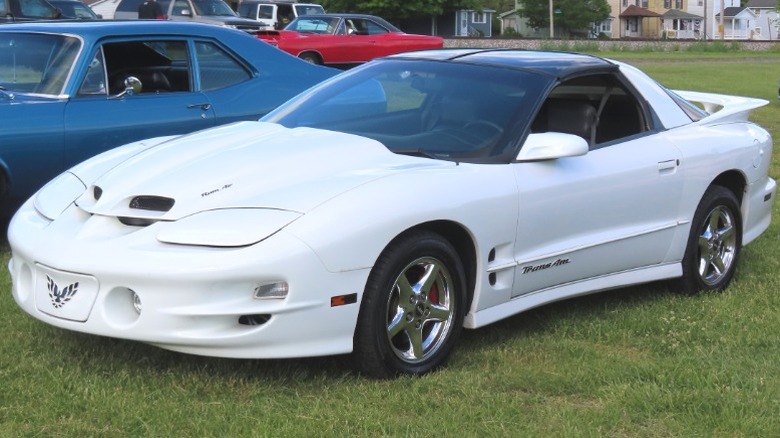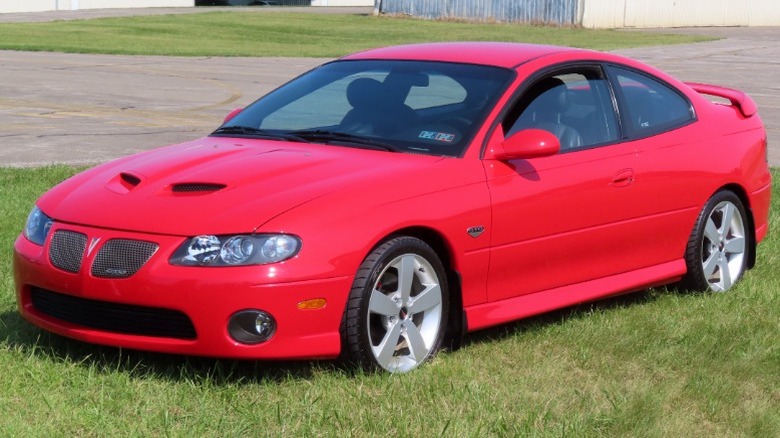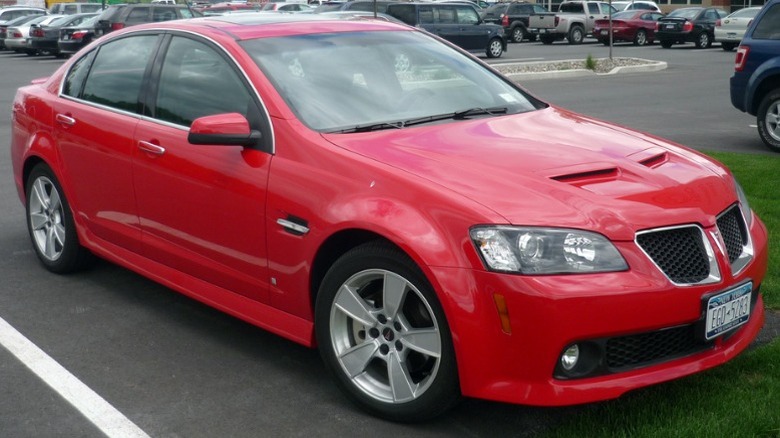Every Pontiac Car Powered By A Corvette Engine
In the century-plus since William Durant founded General Motors, the automaker and its various brands have designed and manufactured all manner of engines, from inline-4s to big-block V8s and plenty in between. For most of the 20th century, GM's divisions developed these engines independently, with each making engines for its own vehicles.
Pontiac, for example, had an in-house 389-cubic inch V8 available in all of its '60s models alongside a beefy 428-cubic inch V8 that exclusively powered mid- and full-sized Pontiacs. There was next to no overlap with V8s from GM's other brands, either, even if they had similar displacements; Chevy's 327-cubic inch V8 only powered Chevy cars and trucks, while Buick's 455-cubic inch V8 had little to do with Pontiac and Oldsmobile's similarly-sized V8s. That all started changing in the late 1970s, though, when cost-cutting measures pushed GM to use engines across multiple brands. In a state of affairs that may seem a bit quaint now, customers of the time were allegedly horrified to find Oldsmobiles, Buicks, and Pontiacs with Chevy engines under the hood, to the point that some of them even took GM to court.
The writing was on the wall for GM's various engine divisions, including Pontiac. The division stopped making V8s altogether after 1981, with future V8 Pontiacs fated to come with Chevy V8s under the hood. These eventually included a selection of Corvette V8s in the 1990s and early 2000s, giving Pontiac one final flourish before GM axed the brand in 2009.
1993-2002 Pontiac Firebird Trans Am and Formula
The Firebird went through a range of visual and mechanical changes over its long life, morphing from a Coke bottle-styled pony car in its first iteration in 1967, to a sleek elongated bruiser by the time its fourth — and final — generation debuted in 1993. The Trans Am and Formula versions of the '93 Firebird packed the 5.7-liter LT1 engine first seen in the C4 Corvette, although its 275 hp and 325 lb-ft of torque were down on the 'Vette's 300 hp and 330 lb-ft.
While the LT1 is technically a Corvette engine, the refreshed fourth-gen Firebird, which debuted in 1998, is what most probably have in mind when thinking of a Corvette-powered Pontiac. For this refresh, GM dropped the LT1 that had been powering the Trans Am and Formula; in its place was the 1997 Chevrolet C5 Corvette's all-new, all-aluminum LS1.
The 5.7-liter LS1 offered a big leap in performance, with both versions of the LS1-equipped Firebird now sporting 305 hp and 335 lb-ft of torque. This propelled the 1998 Firebird Trans Am to a 5.1-second 0-60 mph time in MotorTrend's hands, with the quarter mile coming in 13.4 seconds. If that wasn't enough, Pontiac offered a WS6 package that increased power to 320 hp. The LS1 stayed in the Firebird until GM discontinued the car in 2002, by which point the LS1 was producing 310 hp.
2004-2006 Pontiac GTO
GM revived another storied performance nameplate from Pontiac's past shortly after it killed off the Firebird: the GTO. Dormant since 1974, the GTO was a huge part of muscle car history, often credited with giving rise to the muscle car as we know it. The new GTO, then, had big shoes to fill — and while there was likely no way it could have done so, it still gave a pretty good account of itself nonetheless.
However, unlike the '60s and '70s GTO, this 2004 Pontiac GTO was not an in-house creation. Instead, GM opted to bring the Australian Holden Monaro to the U.S. and installed Pontiac badges in place of the original Holden ones. While it may not have had the original GTO's muscle car aura, the final-generation GTO was a great car according to most, not least thanks to the engine under the hood.
On its 2004 debut, the Pontiac GTO packed the same LS1 V8 from the Firebird, but making a much healthier 350 hp and 365 lb-ft of torque — good enough for MotorTrend to call it "the fastest, most appealing GM muscle coupe in memory." Pontiac went one step further in 2005, introducing the 400-hp, 400 lb-ft 6.0-liter LS2, along with safety updates such as improved traction control and better brakes. Sadly, the GTO never sold well, and GM pulled the plug after only selling 41,000 units in three years.
2008-2009 Pontiac G8 GT and GXP
GM often took to rebadging other cars to sell as Pontiacs, so it made sense that it would try once again with an Australian import, even after the 2004 GTO's failure. A year after dropping the GTO, GM introduced Pontiac's final full-size flagship: the G8.
Like the GTO, the G8 was a rebadged Holden, with GM turning to the Commodore to spearhead Pontiac's return to the major leagues via a rear-wheel-drive platform, great handling, and potent engines under the hood — all at prices that undercut European rivals. Unlike the GTO, though, the G8 was not V8-only. Base G8s came with a 256-hp, 3.6-liter V6; buyers would have to stump up an extra $2,400 for the G8 GT and its 361-hp LS2-derived L76 V8, which in MotorTrend's hands, hit 60 mph in an impressive 5.3 seconds.
GM upped the ante in 2009 with the G8 GXP. The GXP was arguably the pinnacle of Pontiac's final years, partly thanks to the engine under the hood: Instead of the GT's L76, the GXP had the 415-hp, 6.2-liter LS3 V8 that debuted in the 2009 Chevrolet C6 Corvette. Car and Driver managed a 0-60 time of 4.7 seconds, and while it liked the car, it was downbeat about the G8 GXP's future in light of impending fuel economy standards and GM's ongoing financial woes. These concerns were eventually proved correct when GM discontinued Pontiac in 2009 as part of its attempts to avert bankruptcy, bringing an end to the G8 GXP in the process.



